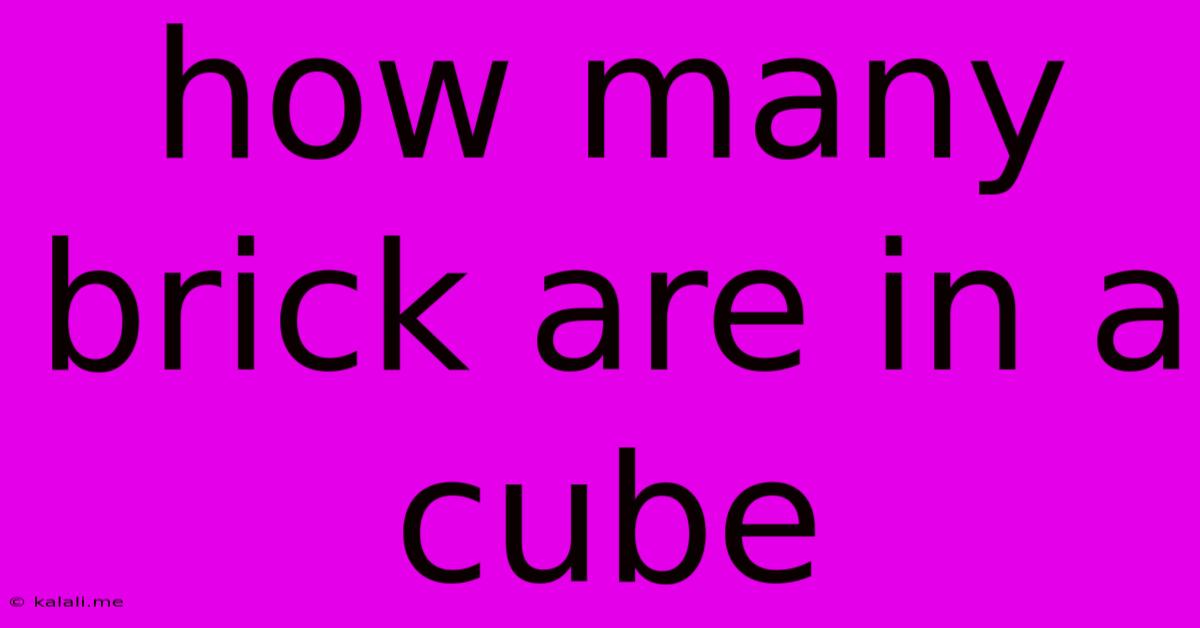How Many Brick Are In A Cube
Kalali
Jun 14, 2025 · 3 min read

Table of Contents
How Many Bricks in a Cube? A Comprehensive Guide to Calculating Brick Quantities
Determining the number of bricks needed for a cubic structure is a fundamental task in construction and masonry projects. This seemingly simple calculation involves several factors, and understanding these factors ensures accuracy and avoids costly material shortages or overages. This article will provide a step-by-step guide to accurately calculating the number of bricks required for your cubic project, encompassing various scenarios and considerations.
Understanding the Variables: The total number of bricks needed isn't just about the cube's volume; it depends on several critical factors:
- Brick Dimensions: Brick sizes vary significantly depending on the region and type of brick. Standard dimensions are often given in inches (e.g., 8" x 4" x 2.25") or centimeters (e.g., 215mm x 102.5mm x 65mm). Always confirm the exact dimensions of the bricks you intend to use.
- Mortar Joint Thickness: The mortar (cement mixture) used between bricks adds to the overall dimensions. A typical mortar joint is around ½ inch (12.7mm), but this can vary. Account for this added thickness in your calculations.
- Waste Factor: It's crucial to factor in a percentage for waste. This accounts for broken bricks, cutting errors, and general wastage during the construction process. A 5-10% waste factor is commonly recommended, but this might be higher for complex projects.
- Brick Laying Pattern: Different laying patterns (e.g., stretcher bond, header bond, English bond) might slightly alter the overall brick count per unit volume. For simplicity, this article assumes a common stretcher bond.
- Cube Dimensions: The precise length, width, and height of the cube are paramount. Use consistent units (inches or centimeters) throughout your calculations.
Step-by-Step Calculation:
Let's assume we're building a cube with dimensions of 10 feet x 10 feet x 10 feet, using standard bricks with dimensions of 8" x 4" x 2.25", and a ½ inch mortar joint.
-
Convert Units: Convert all dimensions to the same unit (inches in this case). 10 feet = 120 inches.
-
Account for Mortar: Add the mortar joint thickness to the brick dimensions. So, each brick's effective dimension becomes 8.5" x 4.5" x 2.75".
-
Calculate Bricks per Layer: Divide the length and width of the cube by the effective dimensions of a brick:
- Number of bricks along length: 120 inches / 8.5 inches ≈ 14.12 bricks. Round down to 14 bricks per layer.
- Number of bricks along width: 120 inches / 4.5 inches ≈ 26.67 bricks. Round down to 26 bricks per layer.
- Bricks per layer: 14 bricks x 26 bricks = 364 bricks
-
Calculate Layers: Divide the cube's height (120 inches) by the effective height of a brick (2.75 inches): 120 inches / 2.75 inches ≈ 43.64 layers. Round up to 44 layers.
-
Total Bricks (without waste): Multiply the bricks per layer by the number of layers: 364 bricks/layer x 44 layers = 16,000 bricks.
-
Add Waste Factor: Assuming a 10% waste factor: 16,000 bricks x 0.10 = 1600 bricks.
-
Total Bricks (with waste): 16,000 bricks + 1600 bricks = 17,600 bricks.
Therefore, you would need approximately 17,600 bricks to construct a 10ft x 10ft x 10ft cube, considering the specified brick dimensions, mortar joint, and a 10% waste factor. Remember that this calculation is based on a simplified stretcher bond. Other bonding patterns might slightly influence the result.
Important Considerations:
- Openings: This calculation doesn't account for any openings (doors, windows, etc.). You'll need to subtract the number of bricks these openings would require.
- Complex Shapes: For non-cubic structures or those with complex designs, consult with a professional estimator or architect for accurate brick quantity calculations.
- Brick Types: Different types of bricks (e.g., facing bricks, engineering bricks) may have different sizes and properties, affecting your calculations.
This comprehensive guide helps you determine the approximate number of bricks needed. Remember to always double-check your calculations and account for all variables before starting your project. Accurate estimation saves time, money, and reduces potential construction delays.
Latest Posts
Latest Posts
-
Find The Prime Factorization Of 75
Jun 15, 2025
-
The Panama Canal Connects What Two Bodies Of Water
Jun 15, 2025
-
Inputs Used To Produce Goods And Services Are
Jun 15, 2025
-
Which Of The Following Is Not A Social Networking Site
Jun 15, 2025
-
Which Of The Following Statements About Eukaryotic Mrna Is True
Jun 15, 2025
Related Post
Thank you for visiting our website which covers about How Many Brick Are In A Cube . We hope the information provided has been useful to you. Feel free to contact us if you have any questions or need further assistance. See you next time and don't miss to bookmark.